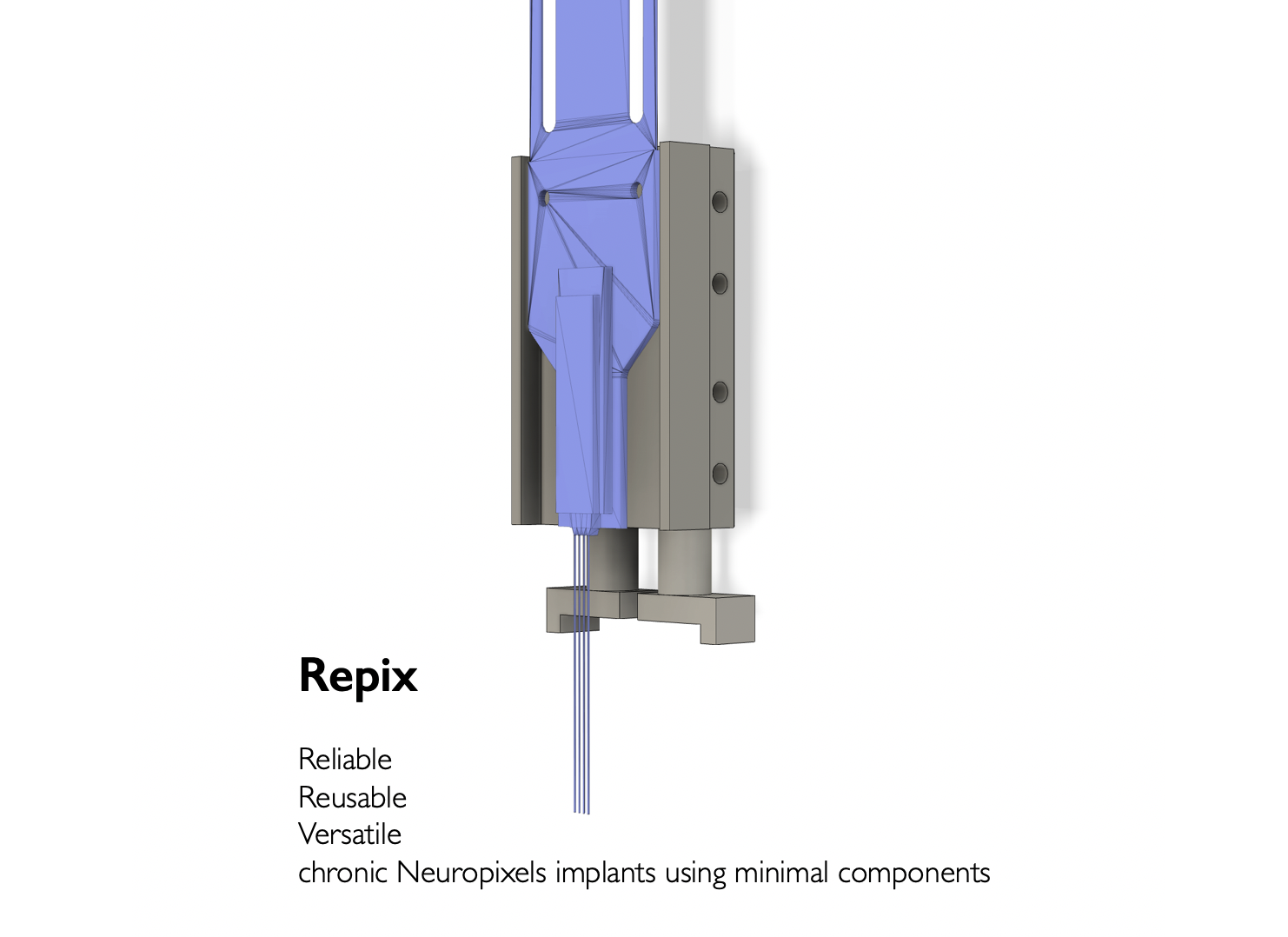
Repix: facilitating chronic Neuropixels recordings
By April Cashin-Garbutt
When studying social behaviours, it is crucial that animals engage in natural interactions. But carrying out neural recordings in freely moving animals can be challenging. Researchers want their recording systems to be:
- stable, so they can record over long time spans, and track single neurons over time
- resilient, so the equipment isn’t damaged, for example by other mice in their interactions
- reusable, so costs can be kept down.
To solve these problems, a large team of scientists at the Sainsbury Wellcome Centre at UCL collaborated with expert engineers in the SWC fabrication laboratory to create Repix.
Introducing Repix
Repix is a new, minimalistic, reusable implant system for Neuropixels probes, the state-of-the-art electrodes for simultaneous neural recordings released in 2017. Encouraged by the community at SWC, the first prototypes for the Repix system were developed by Daniel Regester, a recently graduated PhD student in Yoh Isogai’s former lab at SWC.
“As a molecular biologist by training, I didn’t have an in vivo electrophysiology background. But the support of the community at SWC, and in particular John O’Keefe and Tiago Branco, really encouraged me and my lab to develop this new method,” explained Yoh Isogai, Senior Scientist at the Allen Institute for Neural Dynamics and former Group Leader at SWC.
The team continually sought advice from the SWC FabLab to design parts that could be manufactured in a simple and cost-effective way. This input from the expert engineers at SWC was crucial to the design of Repix, and resulted in a system that is both easy to use and manufacture.

Evaluating the real-world performance of Repix, beyond social behaviours in mice
The initial evaluation of Repix in the Isogai lab showed that the implementation worked well, and the system could produce stable recordings. And so, the system was shared with other researchers. So far, 16 users across 10 labs have implemented the system with more than 200 implantations done. Repix has now been used in both mice and rats, expressing a large palette of behaviours from social interactions to foraging, navigation, working memory, and decision-making.
Inspired by his previous experience in clinical evaluation of surgical devices, SWC PhD student Mattias Horan, came together with other researchers at SWC last summer to begin evaluating the real-world performance of Repix.
“We assembled a census of everyone who had used Repix and carried out a survey on how successful they were in their pursuits. We asked whether they had success with implanting Repix, collecting data, and explanting the system. We also encouraged users to give feedback on what was, and wasn’t, working and we collated all of this in the paper,” explained Mattias Horan, SWC PhD student in the Burgess Lab.
For the users who fully adopted Repix, the average number of procedures it took to become proficient with the technique was around five implantations. The Repix system allowed the probes to be used for up to a maximum of one year and, so far, Repix has been shown to be able to be reused five times for a single Neuropixels probe.
For those who did not succeed in fully adopting the technique, there were a number of pitfalls.
“Some users struggled with applying cement precisely during surgery, as it is important that it only touches the posts and not the cassette, otherwise the probes cannot be extracted and reused,” commented Horan, “and others had probe breakages for example due to insufficient shielding of the electrode itself”.
Implications and next steps
The Repix system lowers the barrier to entry for chronic Neuropixels recordings by enabling scientists, including those without a strong background in this area, to learn how to do in vivo physiology in a diverse repertoire of behaviours including freely behaving, socially interacting animals.
To support users, the team has produced a protocol with best practices that is freely available. They have also shared the files needed to either manufacture, or further iterate Repix to suit experimental needs.
“The Neuropixels community have been fantastic at supporting each other and we are happy to answer any questions on how to set up Repix. We will also be taking part in upcoming Neuropixels workshops,” commented Isogai.
The team also hopes that the Repix system will result in a significant reduction in animal numbers because more data can be recorded from a single animal. “The combination of the high yield of Neuropixels with long-term recordings really starts to unlock the potential of getting massive amounts of electrophysiological data from a single animal,” explained Horan.
In terms of next steps, many researchers want to be able to use more than one probe to record from a single animal. While this feature has not yet been incorporated into Repix, the team are confident that it will be part of the next iteration of Repix, and point to other solutions for chronic implantations that already allow this. They are also working to make Repix even lighter with the advent of newer Neuropixels probes.
About Repix
To find out more about Repix:
- Read the preprint in bioRxiv: ‘Repix: reliable, reusable, versatile chronic Neuropixels implants using minimal components’
- Access the Repix companion protocol
- Contact Mattias Horan or Yoh Isogai for more information
